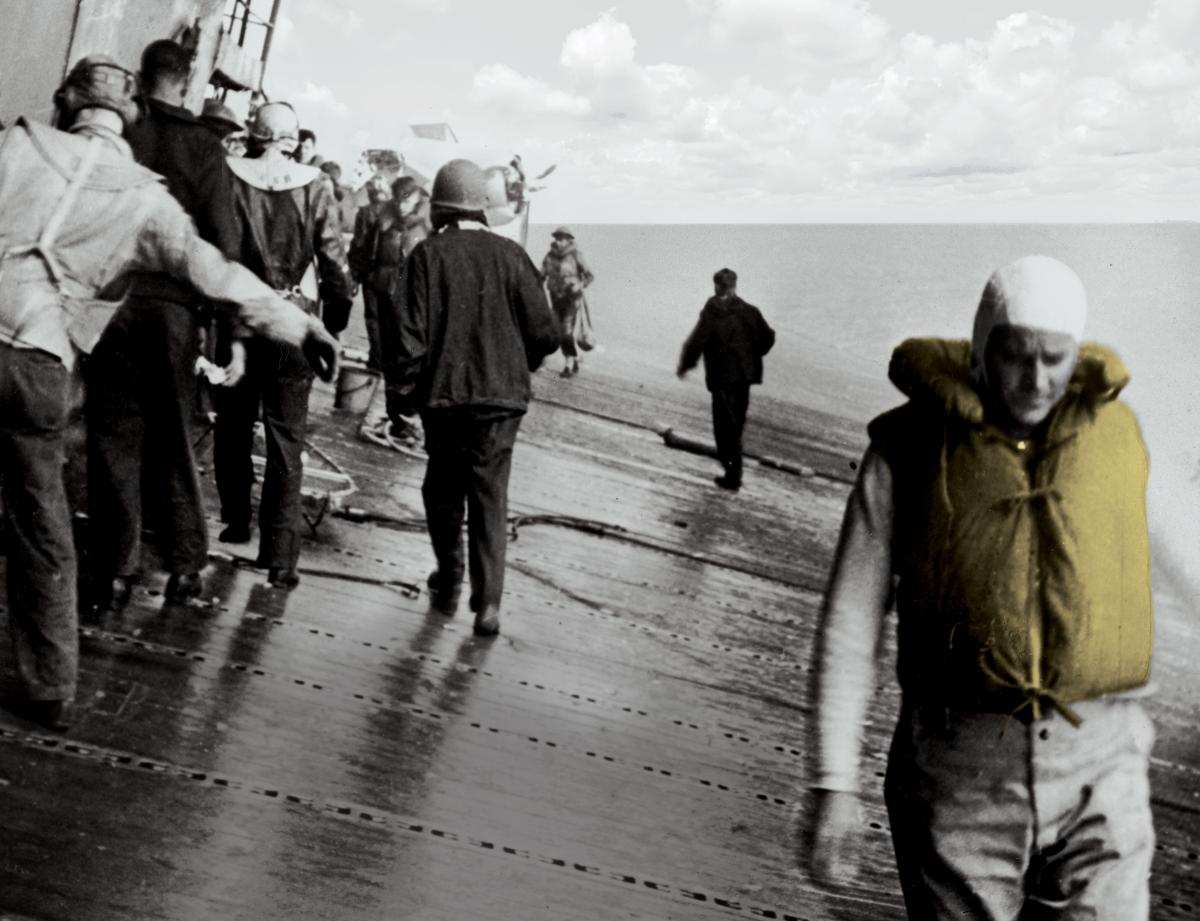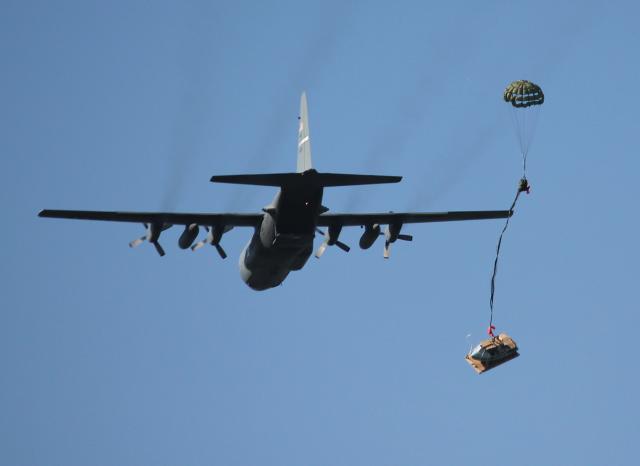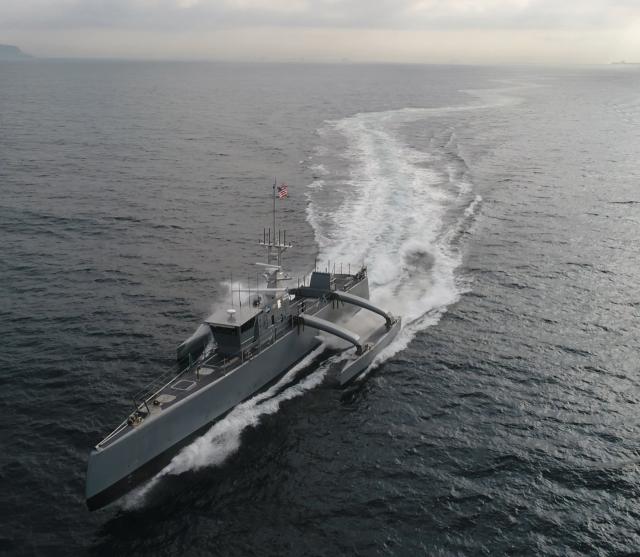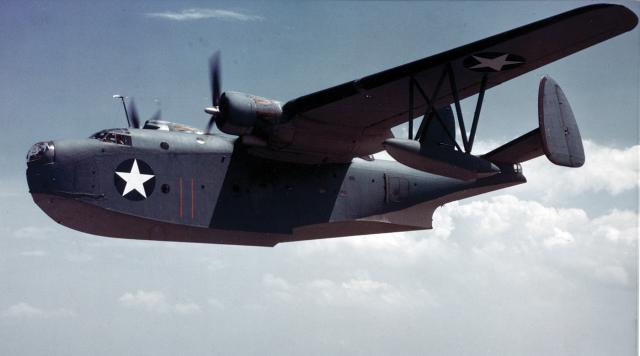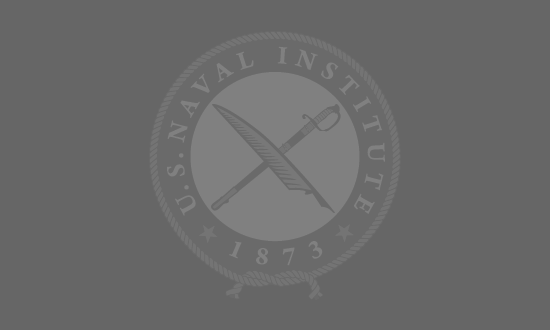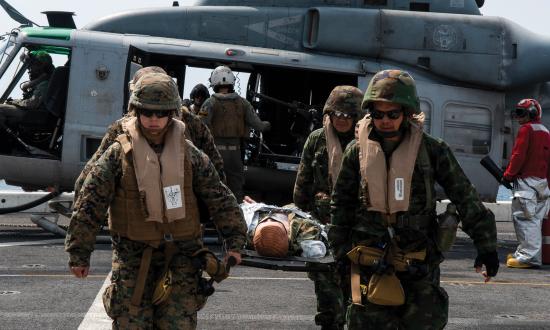In the nearly 76 years since the United States and its allies last fought a coalition of powerful, technologically advanced competitors, there have been profound and revolutionary changes in the character, conduct, and domains of warfare. If a great power conflict were to erupt today, warfare would be on a scale and scope similar to World War II but with greater combat intensity, precision, and lethality, at longer ranges, and with even higher combat losses.
At sea, it is not too far-fetched to imagine the near-simultaneous loss of multiple U.S. and allied carriers, surface combatants, and amphibious warships, as well as hundreds of tactical aircraft and helicopters. This would result in large numbers of surviving crews and aircrews going into shark-infested waters to await rescue and recovery by friendly forces. If, like the Japanese fleet at the battles of Coral Sea, Midway, and Guadalcanal, the U.S. fleet were forced to rapidly withdraw because of enemy presence, antiship missile threats, or some new adversary weapon, thousands of trained and experienced U.S. and allied men and women would either be left to the rescue clemency of the enemy or, more likely, perish at sea.
Every battle—win or lose—will demand that joint U.S. and allied forces be ready to provide large-scale, timely, and effective combat search, rescue, and recovery (CSRR) of both friendly and adversary survivors. The initial challenge will be to locate survivors across a widely distributed and dispersed battlespace, get them out of the sea and into life-raft shelters, and provide them with adequate supplies to sustain them until they can be recovered by friendly forces. These mass survivor rescue activities will need to be planned and conducted within a hostile or contested battlespace, either during or immediately after an intense and confusing combat engagement.
Given the challenge, will U.S. and allied commanders and forces be prepared and ready? If not, what can be done?
Four First Steps
First, recognize the criticality. Service needs always exceed the money available, and large-scale CSRR is another competing need. However, the Department of the Navy needs to raise CSRR’s priority and stop seeing it as a budget drain or a post-engagement lesser-included task. It is a critical enabling operation across all phases of a campaign that keeps faith, maintains morale, and returns badly needed knowledge and experience to joint and naval forces when survivors return to fight again.
Second, plan and exercise. The simultaneous loss of one or two carriers or amphibious assault ships and several surface combatants or a hundred-plus aircraft and aircrew could mean as many as several thousand service men and women bobbing and exposed in a dangerous sea. Though it is a terrible possibility to contemplate, planning and exercising for such an eventuality is imperative. Insights gained and lessons learned could lead to the next generation of fleet-generated innovation and requirements for life-saving technology, equipment, and platforms. Though there may not be money today for new programs, the Navy Department can plan and exercise with on-hand aircraft, ships, equipment, and technologies to build a foundation for the future.
Third, provide funding. The services can begin today to innovate with existing platforms and procedures and stockpile equipment and supplies needed to rescue and recover survivors. But sustained, steady-state funding is needed to develop, tailor, and field new technology combinations and platforms to provide timely and effective CSRR capability and capacity for the future.
Fourth, develop unmanned platforms. The services need to think differently about CSRR. One option is to develop a mix of lower cost, highly reliable, autonomous or semiautonomous unmanned and minimally manned platforms that are capable of timely, long-range, mass survivor search, rescue, and recovery support operations.
A Future CSRR Force
A future CSRR force mix could include:
Aerial and high-speed surface search vehicles. These vehicles would carry multispectral sensor packages designed to identify floating wreckage, life-rafts, and individual and groups of survivors in the water. They also would be capable of sharing locations and delivering initial rescue/survival equipment, such as the Greenough Advanced Rescue Craft (GARC); large life-raft shelters; floating medical, communications, and survival supplies; and water-making and other technologies.1
In the short term, new sensor technologies and survival packages could be retrofitted on or delivered by existing Navy and Marine Corps platforms, such as the C-130, P-8 Poseidon, MQ-4C Triton and MQ-25 Stingray, and CMV-22B Osprey. In addition, small unmanned surface vehicles (USVs) such as the GARC could be operated by every surface combatant and in large numbers by an expeditionary fast transport (EFT) mothership, extending their hosts’ surface-search range and operational reach by several hundred miles. These small, low-profile, low-cost, highly reliable, and easily maintained USVs could pair with a Towed Airborne Lift of Naval Systems (TALONS) parafoil containing an electro-optical/infrared/signals intelligence/radar sensor package designed for surface and survivor search and location reporting.2
In the long term, all manned platforms could be either augmented or replaced by lower cost unmanned, optionally manned, or minimally manned aerial, surface, and semisubmersible craft with the speed, range, endurance, and low physical and electronic signatures needed to clandestinely establish and operate picket, search-and-rescue, and lifeguard stations within the contested contact layer.
Low-profile autonomous or minimally manned surface and semisubmersible craft. These craft would be designed for long-range, high-speed surface transit to assume and maintain lifeguard stations. Like the submarine and surface combatant lifeguardsof World War II, they would take station ahead of the U.S. and allied battle fleets conducting strike and combat operations.3 They would be in position to move rapidly to rescue and recover downed aircrew and/or aid survivors of sunk U.S. and allied warships. Platforms such as DARPA’s Sea Hunter or low-profile surface craft such as the SEALION Combatant Craft (Heavy), for example, could transit long distances at relatively high sustained surface speeds and, on arrival in their lifeguard zones, remain there clandestinely for extended periods.4 They would operate similarly to their diesel submarine counterparts of World War II but be substantially smaller and less costly.
Surface wing-in-ground-effect aircraft or next-generation seaplanes or amphibians. As long-range, low-altitude search, rescue, and recovery platforms, these aircraft would have survival equipment delivery capabilities, as well as the capability for water landing and personnel recovery in sea state 5 conditions. Past and current flying boat or amphibious designs such as the World War II/Korean War Martin PBM Mariner or Japanese US-1 and US-2 ShinMaywa could be evolved toward a next generation seaplane or a surface wing-in-ground-effect amphibious aircraft designed for long-range mass CSRR.5
Modified high-speed auxiliaries such as the EFT as motherships. These ships would operate as part of the battle fleet. They would be designed or modified for rapid, multipoint, underway launch and recovery of manned and unmanned aerial, surface, and semisubmersible CSRR vehicles. As part of the battle fleet, they would be integrated in composite warfare planning and be able to establish supporting picket and lifeguard lines in advance along expected avenues of approach and combat. In this manner, the fleet could provide some of its own timely CSRR support to downed aircrews and the crews of sunk warships.
A Daunting Challenge
Mass survivor rescue and recovery is a daunting challenge, but solutions do not require groundbreaking materials and technologies. With planning, steady funding, and iterative development and fielding of operational and technical solutions, the Department of the Navy could field a lower cost yet capable mix of autonomous and minimally manned aerial, surface, semisubmersible, and submersible platforms to perform CSRR missions across a vast battlespace.
History has multiple tragic examples of what could happen to modern combat survivors awaiting rescue at sea.6 Warships and planes are replaceable. Trained, experienced, and courageous warfighters are not. Revitalizing fleet capability and capacity for long-range mass survivor combat rescue and recovery is a not a luxury; it is a necessity.
1. See Elizabeth Hines and James Cerulli, “GARC Military Rescue Boat: Versatile Rescue Craft for Shallow and Open-Ocean Missions,” Sea Technology (reprint), www.mapcorp.com/wp-content/uploads/ST_ReprintGARC.compressed.pdf.
2. Defense Advanced Research Projects Agency, “TALONS System Mimics a Mast as Tall as a Skyscraper,” 24 September 2015, www.darpa.mil/news-events/2015-09-24; “TALONS Tested on Commissioned U.S. Navy Vessel for First Time,” 15 August 2017, www.darpa.mil/news-events/2017-08-15.
3. William Gruner, “U.S. Pacific Submarines In World War II,” v. 3.04, San Francisco Maritime Park Association, 2016, https://maritime.org/doc/subsinpacific.htm#pg8.
4. Joseph Trevithick, “Navy’s Sea Hunter Drone Ship Has Sailed Autonomously to Hawaii and Back Amid Talk of New Roles,” 4 February 2019, The WarZoneWire, 4 February 2019, www.thedrive.com/the-war-zone/26319/usns-sea-hunter-drone-ship-has-sailed-autonomously-to-hawaii-and-back-amid-talk-of-new-roles; and H. I. Sutton, “Sea Lion and Alligator Stealth Boats,” Covert Shores, 13 February 2017, www.hisutton.com/SEALION%20and%20Alligator%20stealth%20boats.html.
5. ShinMaywa Industries, “By Land, Sea, or Air US-2,” Product Information, 2017, www.shinmaywa.co.jp/aircraft/english/us2/us2_capability.html.
6. Lynn Vincent and Sara Vladic, “USS Indianapolis: Survivor Accounts from the Worst Sea Disaster in U.S. Naval History,” History.com, www.history.com/news/uss-indianapolis-sinking-survivor-stories-sharks.



